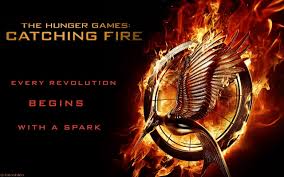On paper, the premise for The Hunger Games series seems rather weak. Actually, I think my immediate response when it was first described to me was, “But I read The Most Dangerous Game in seventh grade English class.” The person with whom I was speaking had no idea what that was, so the conversation ended without my wondering aloud if The Hunger Games series of Young Adult Novels would be, for most young readers, the stepping stone between Harry Potter and Fifty Shades of Grey. Despite my initial misgivings, I do regret not having jumped on board with the series sooner, for I feel I have missed a large piece of the pop culture progression in these kinds of books (and movies).
For those that aren’t familiar with the premise, the story goes that in the not-quite-distant future, in a country called Panem, unfortunate teenagers are selected to kill each other on television. Our hero, Katniss, is a lovely young lady blessed with both a talent for archery and plenty of restless-teen-iconoclasm. Violence and ingenuity ensues. We’re rooting for you, darlin’.
What stands out to me about telling this story visually, though, is how well-executed the social commentary from the novel is presented. In the sequel, Catching Fire, the actual Hunger Games are less than half of the movie, while the first half deals with the aftermath of Book / Film Number One and beautifully illustrates the world in which these characters live. They are treated as heroic representatives of their home districts, trained in state-of-the-art facilities, given incredible stylists (Lenny Kravitz!), and are interviewed until the masses feel they have built a personal connection to the people they will soon watch die. Actually, the most moving scene takes place on what appears to be the stage of American Idol. And then they’re off to play Survivor.
As I watched Catching Fire, I couldn’t help but be slightly disturbed. I felt like I had received a mild sucker-punch upon the realization that this movie is totally realistic. Hollywood politicking, a reality show, and government-run violent entertainment conspire to create a situation where the masses become emotionally attached to people who are being killed for their amusement. And then they do it all over again next season. And this isn’t some Mad Max post-apocalyptic dystopia… this is glamorous. Dystopian nonetheless, but camouflaged by a charming celebrity host who looks like a cross between Fabio and Clay Aiken, with a disturbing fake-n-bake tan no less.
My point in all this is that by the time the movie ended, I was engaged. The characters are well-presented despite the fact that a large chunk of the film is spent running around in the jungle. The pacing is solid and the acting respectable. The cinematography and special effects are difficult to distinguish from one another, so there is little distracting CGI. And best of all, the story (especially the ending) made me want to see the next one when it comes out. In other words, none of the nit-picky that a reviewer should harp on was intrusive enough to distract me. And that’s really great, because there’s a pretty clear warning in this film directed at teenagers on date night.
I think it’s just stating the facts when I say that most of “the kids” who see this movie will see it before reading the books. Sure, the books have their dedicated fanbase, but there will be a lot more people reading them now. And if my theory from the first paragraph holds true, then the timing is really perfect.
[rating:3/4]
Cast: Jennifer Lawrence, Josh Hutcherson, Liam Hemsworth, Woody Harrelson, Elizabeth Banks, Lenny Kravitz, Philip Seymour Hoffman, Stanley Tucci, and Donald Sutherland
Directed by: Francis Lawrence
Based upon the novel: “Catching Fire” by Suzanne Collins
Rated: PG-13



Randy Steinberg liked this on Facebook.